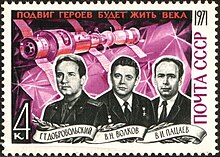Salyut 1
| Salyut 1 | |
|---|---|
 Drawing of the Salyut 1 with an approaching Soyuz spaceship |
|
| Mission data | |
| Begin: | April 19, 1971 1:40:00 UTC Baikonur 200/39 |
| Re-entry : | October 11, 1971 |
| NSSDC ID: | 1971-032A |
| Crews: | 1 |
| Manned in orbit: | 23 days |
| Total in orbit: | 175 days |
| Earth orbits: | 2,929 |
| Apogee: | 222 km |
| Perigee: | 200 km |
| Orbital time: | 88.5 min |
| Orbit inclination: | 51.6 ° |
| Covered track: | 118,602,524 km |
| Total mass: | 19,400 kg |
Salyut 1 was the world's first space station and the first in the Salyut series. It was developed and built in the Soviet Union .
Start and configuration
Salyut 1 was launched on April 19, 1971 on board a Proton rocket. Derived from the Almas program and manufactured under time pressure, the station essentially consisted of an Almas shell and components from the Soyuz spaceship . It was the basis for the civil space station type DOS ( Russian ДОС, Долговременная орбитальная станция , Dolgowremennaja orbitalnaja stanzija for "long-term orbital station"), which differed more and more clearly from the Almas stations as the program progressed. Salyut 1's equipment included a solar telescope , a spectrometer , an electrophotometer and a TV system. In addition, the secret radiometer Swinets and the UV instrument Orion , with which rocket launches on Earth could be observed, were on board. However, the solar telescope was not ready for use because a cover on the outside of the space station had not come off as intended. The control in space and part of the energy supply were carried out via a complete Soyuz service module with solar panels at the rear. A coupling adapter and another pair of Soyuz solar panels were installed on the bow. The total length of the stations was almost 16 meters, their weight around 18.9 tons. Originally the space station should be called Zarya (Заря); however, this name was changed shortly before the start to avoid confusion with the callsign of the ground station .
Mission and Crew
Unsuccessful coupling of Soyuz 10
The station was to be manned and put into operation by the three crew members of the Soyuz 10 mission , which started on April 22nd from Baikonur and already had experience with rendezvous maneuvers from the Soyuz program. Soyuz 10 docked with the space station on April 24, but was unable to establish a pressure-tight or electrical connection to Salyut 1. Since the hatches could not be opened and the crew also did not have spacesuits with them for exits, the station could not be entered and the crew of Soyuz 10 had to return to earth.
First crew of a space station: Soyuz 11
The spaceship of the following mission, Soyuz 11 , received a reinforced coupling adapter to avoid another defect. The start was on June 6, 1971 and a day later a successful coupling to Salyut 1 could take place. After briefly entering the station, the crew retired to the Soyuz spacecraft for the night, as a burnt smell was found in the station and it was decided to change the station atmosphere. During the stay on Salyut 1, the cosmonauts carried out various earth observations and scientific experiments. On June 26th, the planned scientific and technical experiments were completed. The remaining days were used for physical training to prepare for the return and to prepare Salyut 1 for the arrival of the next crew. After 23 days on board the station, the crew disconnected from their Soyuz spacecraft on June 29, 1971 and prepared for landing. When the orbital module exploded, an air valve opened unexpectedly and the landing capsule lost its atmosphere during re-entry, which resulted in the deaths of the three cosmonauts Georgi Dobrowolski , Viktor Pazajew and Vladislav Volkov .
After Soyuz 11
After Soyuz 11 a second, if possible a third team should have lived and worked in Salyut 1. Due to the accident, however, more manned Soyuz flights were postponed and initially unmanned test flights were carried out to restore the safety of the Soyuz. Nevertheless, attempts were made to keep the station in space and the orbit was raised three more times, the last time in August even significantly. Since the next manned Soyuz flight could not take place until two years after the accident due to delays in the Soyuz program, Salyut 1 could not be manned again.
Salyut 1 was originally designed for a useful life of three months. Nevertheless, the ground control was able to collect valuable data on fuel consumption, attitude control and altitude loss of the station even beyond this period of use. With the fuel nearing the end, the end of the space station was initiated with a lowering of the orbit on September 25th. In order to avoid a loss of control and thus an uncontrolled crash, the command for the last braking maneuver was finally given on October 10, 1971. After 175 days in orbit, Salyut 1 entered the Earth's atmosphere over the Pacific on October 11, as planned, and burned up.
Web links
- Raumfahrer.net: Salyut: The way to the Russian space station
supporting documents
- ↑ Salyut 1 in NSSDCA Master Catalog , accessed on 8 December 2008 (English).
- ↑ a b c Saljut 1 in the Encyclopedia Astronautica , accessed December 8, 2008 (English).
- ↑ The three cosmonauts died the "diving death"
- ^ A b Sven Grahn: Salyut-1, its origin, flights to it and radio tracking thereof. Retrieved December 8, 2008 .

